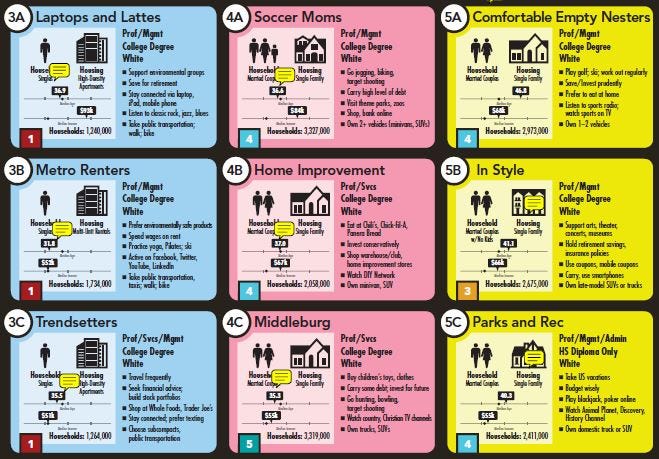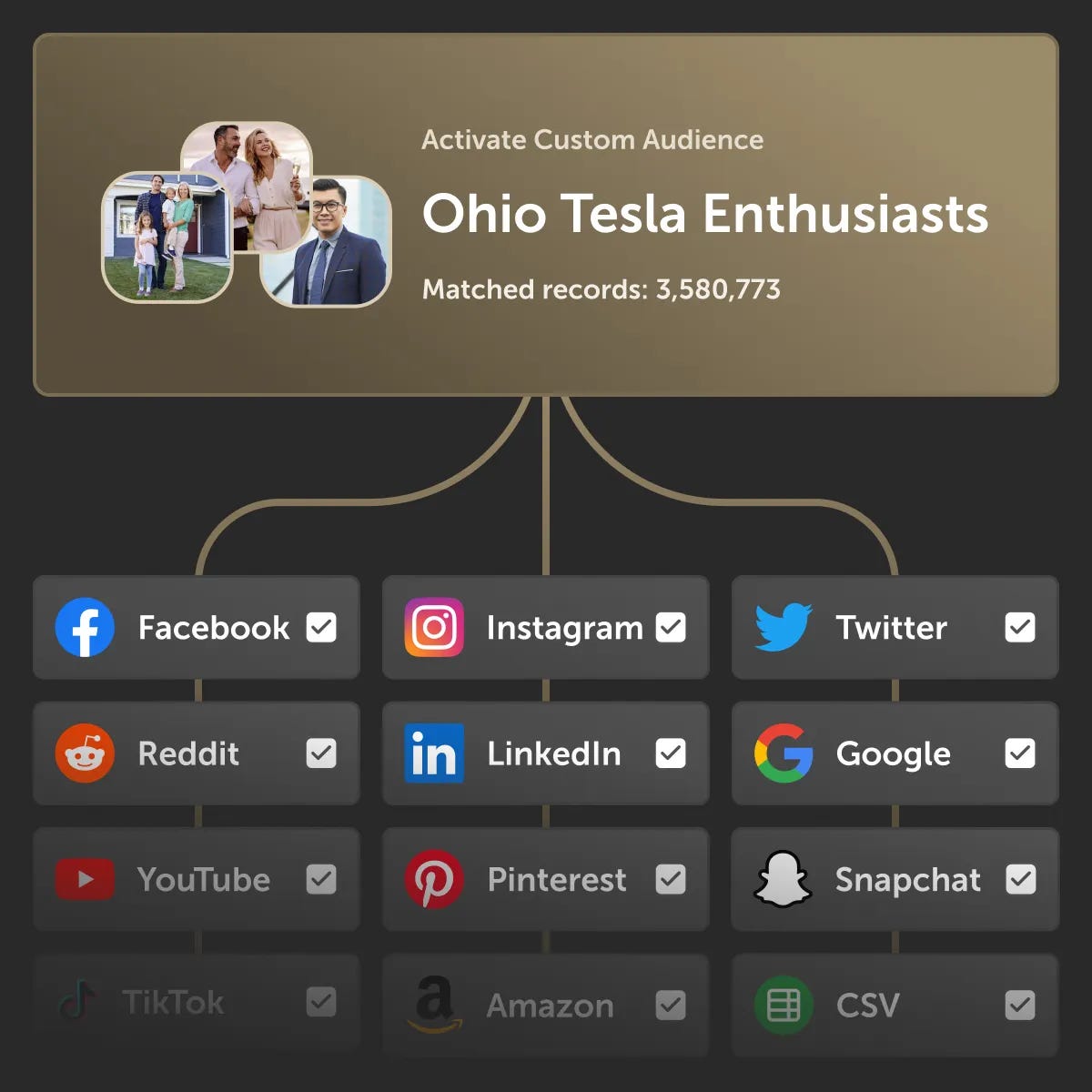Use Data Like The Big Franchise Gyms To Understand Your Core Customer
Only the big players had access to Customer Segmentation data, until now.
WTF is Customer Segmentation??
Customer segmentation (CS) is not a term often discussed amongst small business owners, especially those who bootstrapped their concept and have been humbly grinding through entrepreneurship.
For the purpose of this conversation, let’s apply an operational definition:
Customer segmentation categorizes individuals into broad groupings and further distills them into specific segments based on a combination of data points, including:
Geographic — where they live, work, shop, play, etc…
Demographics — gender, race, age, income, etc…
Psychographics — personalities, lifestyle characteristics, values, interests, etc…
Buying Habits — where, what, when and how much they purchase…

This data is extracted from us every day, at every transaction we make and every form we fill out. Big data is aggregated across dozens of organizations like the three credit bureaus (Experian, Equifax and TransUnion), public records and online activity monitoring — to name a few.
CS is constantly discussed amongst accomplished independent and franchise fitness brands who are scaling their growth with new locations, in new markets.
But it’s not just the established players that are leaning into this data.
Well-capitalized startups who are speculating as to who their core customer is are also using CS data to help them with their branding, marketing, and location decisions.
And the rest of us smaller players…well, the only CS we’ve ever referred to is “Customer Service”. But it’s time to change that.

How Will Customer Segmentation Data Grow My Business?
“This is a great and all, Stu — but I already know who my core customer is! Check it out:
48% women
Ages 25–50
Professionals with good careers
Many have kids, but some don’t.
Most live within 15 minutes of the gym…but I know we have some members that travel far too.
They want to be fitter, healthier and have more energy throughout the day.
Can you envision my eye roll happening? Good, because I’m staring at the back of my fucking skull.
48% women→ You just described every gym +/- a few points.Ages 25–50→ Did you just list a 25-year range as your core customer? You do realize that the problems, wants and needs of a 26-year-old and 46-year-old are world’s apart, right??Professionals with good careers→ WTF does this even mean? An acceptable response would have been “Tech and financial service professionals, whom most are established mid-upper management, with an average Household Income of ~$147,000.” Not that generic bullshit you provided.Many have kids, but some don’t.→ At this point, I kinda wish your parents didn’t.Live within 15 minutes of the gym→ If there is actual data to back this up, not just your anecdotal take, then rock on. Otherwise, this is a poor man’s stat line.They want to be fitter, healthier and have more energy throughout the day. → Who the fuck doesn’t? You literally just identified everybody, everywhere.
Bottom Line:
Most small business owners claim to know their core customer — yet we all utilize anecdotal data and make statements like…
“I feel like all must customers are [insert bullshit].
The reason Orangetheory Fitness and MADabolic can open up in your city, crush a pre-sell and legitimately threaten the other group fitness models in their local market is not because they “felt like our core customer is here.”
It’s because they have actual data to back it up.
Here’s how it works.
You’re Sitting On A Winning Lottery Ticket. Let’s Cash It In.
Using the existing data you have within your member management software or CRM, you can access a world of information regarding your actual core customer via CS data.
Step 1: Gather Data
Using a simple CSV file with basic contact information, compile a list of every client you’ve ever had and currently have. No leads or prospects. Only include people who have been or are currently customers.
Step 2: Submit The Data To A CS Service
Now that you have all your customer data, you need to provide it to a company who can interpret and analyze it. This is where they have roadblocked small business owners for years.
If your company has 10,000+ customer records, you can go straight to Experian Mosaic™️ (one of the prevailing CS models) and for a hefty five-figure fee, they will process your CSV file for you.
Step 3: Finally Understand Your Core Customer
Now you have a full CS report, outlining intricate details about your core customer. All the basic information like demographic and geolocation are included, but the fascinating stuff goes much deeper.
What type of ads do they respond to?
How far are they willing to travel to use my services?
Do they have kids or planning on having kids?
Are they likely to move in the next 5 years?
What other brands do they buy from? (in-person and online)
What driving route do they take to get to my gym?
Which social media channels are they most active on?
Do they buy athletic apparel from Lululemon or Target?
And much, much more. To be honest, it’s a little creepy how much data we have access to.


Now That You ACTUALLY Know Your Core Customer, What Now?
Your CS report will provide a full quantitative and qualitative breakdown as to who your core customer is — but what exactly are you supposed to do with that information?
Branding
Knowing who is actually a fan of your brand allows you to further dial in your brand’s messaging, tone and voice. This is why brands like MADabolic can make public messaging that says, “We don’t want you to stick around after class” and it actually makes them MORE money and creates MORE brand loyalty.
See, MAD has invested in CS services so they know exactly what types of communication, policies, and changes they can make that will align with their core customer, not turn them off.
Site Selection and Location Planning
Regardless of whether you’re looking to open your 1st or 100th location, knowing where your core customer lives, works, and plays is one of the most important pillars to success when choosing a site. And with a proper CS profile, we can map out exactly where to go to access your core customer.
Marketing
If you’re currently running paid advertising on social media, you can now use your CS report and directly target those exact lookalike audiences. It takes the guess work out of your ad targeting and allows you to ensure that the right people are seeing your content.
By leveraging your CS reports within the various ad management platforms like Facebook, TikTok, Instagram, Amazon, etc. — you can enhance your ad targeting far beyond your current efforts. More customers, less wasted money.
Sounds Awesome, Right? So Why Aren’t You Already Doing This??
It’s likely this is the first time you’ve heard of customer segmentation, and that’s also part of the problem. This business solution has only made available to the big players until now.
I’ve spent the past 12 months being trained on this type of software and testing its efficiency on select cohorts of business and commercial real estate clients.
And the verdict is in — this shit works.
To learn more and get started, click here.
If you have specific questions, just reply to this email.







